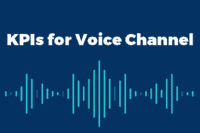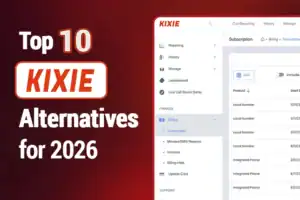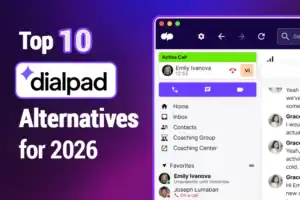As the key to customer relations between companies and consumers, the contact center and more specifically agents, must respect a perfect showcase of a brand for the outside world. Response time, resolution rate, agent efficiency… It is essential to keep an eye on every metric in order to ensure service quality that is consistent with the company’s brand image! After all, contact center managers and supervisors must be able to readily determine the areas of work to enhance the degree of customer satisfaction once they have correct statistics.
Despite the emergence of new digital communication channels and self-care, the voice channel, or more simply telephony, remains the primary communication channel favored by consumers. As a result, in this article, we look at the most important key performance indicators (KPIs) for the voice channel and how technology may help to enhance them.
The Average Handling Time (AHT)
Call centers are an excellent investment when it comes to customer care, whether you are assisting your staff or your consumers. But how do you tell whether they’re actually working? How can you guarantee that support agents’ work is truly beneficial to the clients who call you? The answer to these questions is whithin the key performance indicators, which must be assessed on a continuous basis. This is an excellent approach for enhancing the customer experience while also developing a corporate culture based on the quality of service provided by your contact center.
AHT is an abbreviation for “Average Handling Time.” It is one of the most typical criteria assessed in contact center support services. As it reflects the average duration of a customer engagement, which is generally calculated from the beginning of the call and includes the full discussion and hold time to the end of the call.
In general, contact centers aims to minimize AHT. Both to decrease operational expenses (the shorter the AHT, the more calls may be handled) and to deliver the most efficient user experience possible. They will be more happy if their problem can be handled in 3 minutes rather than 20 minutes. The delicate balance is to deliver quality service without sacrificing the client experience, while also addressing the issue so that a follow-up contact is not required.
How can technology be used to drive low AHT?
 Badly trained call center agents, information fragmentation across systems, a non-existent or poorly documented knowledge base, numerous individuals managing the same issue, and so on.
Badly trained call center agents, information fragmentation across systems, a non-existent or poorly documented knowledge base, numerous individuals managing the same issue, and so on.
A lower AHT might be equated to improved resource use. Shorter calls equate to more calls per agent and higher income. This contact center KPI may be extremely helpful in determining the level of service, team efficiency, and determining whether an employee requires more training to rapidly handle client concerns.
The Average Handling Time is frequently impacted by typical difficulties like agents having to transfer between multiple computer systems or platforms, computer systems being sluggish, and the agent not having access to the customer’s history. To minimize AHT, you should concentrate on:
- Devices that are quick and have a strong internet connection. This should be a top focus in any call center – the infrastructure should not have an impact on performance or customer satisfaction.
- Agents benefit from an intuitive and consistent platform. Agents are more challenged by outdated and unclear platforms with dispersed information. Everything goes more smoothly and swiftly when all of the information is easily available and searchable.
- Excellent instruction. Agents must be well-versed in the subject matter they are discussing. If the agents have had adequate training, their replies will be prompt and realistic. Remember that dealing with consumer doubts is typical at first.
- Support platform that is up to date and easy to use: An FAQ, knowledge base, or help site can provide answers to many consumer questions. Redirecting clients to a web page that has the information they require saves time for both parties.
- Intelligent Call Routing: Using artificial intelligence, this functionality comprehends the customer’s request. Based on a set of rules, it queues and directs the request to the appropriate agent or service. When this is implemented in a contact center, AHT is reduced and customer satisfaction is increased because they are no longer transferred or queued.
- Call routing also should be used to limit the pooling of call center teams: Call center agents that work for many clients must learn multiple interfaces, be familiar with various process manuals, and constantly adjust in order to maintain a solid cadence. This invariably results in a reconditioning period and, as a result, a loss of efficiency. The ideal is to restrict pooling in order to strike a decent balance… it is critical not to jeopardize the quality of responses!
In 2021, it is vital for your organization to have a Cloud Contact Center Solution that not only allows you to unify customer data, unify the systems used by agents and supervisors, but also to navigate between telephony and other communication channels. Such capabilities can be found in NobelBiz Omni+, a true omnichannel solution that delivers a true omnichannel experience. Equipped with productivity tools that can meet the needs of types of contact centers, regardless of their size, industry or activity (Inbound, Outbound or Mixed).
After-Call Work (ACW)
ACW is an abbreviation that stands for “after-call work.” It is a metric that evaluates how long it takes for a call center representative to document and finish activities following each client encounter. It comprises, among other things, the following:
• The reason for the interaction is recorded.
• The actions taken and the outcome.
• Actions to be taken in the future are being planned.
• The customer file is being updated.
The ACW, as you can see, is a component of the AHT. Or more simple, the AHT encompasses both user interactions and ACW. By attempting to keep post-call work to a minimum, you are also assisting in lowering the average handling time.
How can you minimize your ACW without impacting quality ?
If you have the appropriate tools whithin your contact center solution, it will save valuable time for your agents. In that regard, the more clear and precise your agent interface is, the more efficient they may be. They can even conduct part of this work while on the phone with customers, describing what they are doing and how it will help them (making sure they have the right information, the right date, that they have the right interaction topic, etc.).
Furthermore, the advent of IA technologies currently provides solutions that ease qualifying and resolution work by recommending categories and solutions. As a result, the agent is assisted in the entry and closing of the case, resulting in increased efficiency and productivity.
First Call Resolution ( FCR)
 First Call Resolution is a KPI that evaluates the percentage of issues addressed on the first phone conversation. Customers like having their concerns handled quickly, and addressing them in a single call not only promotes satisfaction but also saves call center resources. To calculate CRF, divide the total number of customer concerns reported in the same time period by the number of issues addressed in one call.
First Call Resolution is a KPI that evaluates the percentage of issues addressed on the first phone conversation. Customers like having their concerns handled quickly, and addressing them in a single call not only promotes satisfaction but also saves call center resources. To calculate CRF, divide the total number of customer concerns reported in the same time period by the number of issues addressed in one call.
What is the significance of FCR in call centers? A high RCF indicates that operational costs are kept to a minimum. A low CRF, on the other hand, indicates that the contact center is squandering resources on inefficient procedures.
Furthermore, this statistic affects customer satisfaction: a greater FCR translates into a more pleasant customer experience (and, as a result, a better customer lifetime value (CLTV)).
This measure is strongly connected to AHT: if AHT falls but FCR rises, it indicates that client calls are not being handled satisfactorily.
How to increase the Fist Call Resolution?
- You must dispose of contact center solution that is both intuitive and sophisticated. To enhance FCR, agents must have access to all of the customer’s information and context, as well as the tools needed to fix the issue. Agent routing skills, artificial intelligence, and automation are all beneficial in optimizing call flow and guaranteeing greater FCR.
- Data must be centralized: it is best to avoid switching platforms or transferring calls. Agents should have access to a simple system that shows cross-functional services such as billing and technical assistance without difficulty.
- Determine customer journeys and call routing: To forecast the client’s future moves, common doubts and consumer inquiries must be considered. Each issue must be intelligently directed to the appropriate agent via call routing.
The Next Best Action (NBA)
 The NBA or Next Best Action is the specific action advised by the agent to the customer after the primary problem has been resolved. For instance, suppose a consumer call for an insurance claim. After assisting with his request, the ideal next step would be to recommend added service. The next best step may also be to allude to an insurance product that meets this customer’s needs and that fits the existing conversation, therefore boosting up-selling or cross-selling. It might be regarded the next best option in this scenario.
The NBA or Next Best Action is the specific action advised by the agent to the customer after the primary problem has been resolved. For instance, suppose a consumer call for an insurance claim. After assisting with his request, the ideal next step would be to recommend added service. The next best step may also be to allude to an insurance product that meets this customer’s needs and that fits the existing conversation, therefore boosting up-selling or cross-selling. It might be regarded the next best option in this scenario.
The NBA, on the other hand, may be much more than an offer; it can be a vehicle for engagement and retention. The NBA may also be referred to as the “Next Best Experience” in this situation. It can be an action such as creating an alert for a follow-up call, sending a thank you message, emailing instructional information to the user, or any other activity that aims to strengthen the customer’s loyalty to a brand.
Some companies view NBA as a process that can aid in the achievement of other KPIs rather than an actual metric in and of itself. For example, after adopting an NBA approach, a contact center may track how many of the optimal actions were carried out, how many had favorable outcomes, and the proportion of failure.
Can the NBA be enhanced?
The Next Best Action is one of several call center KPIs that requires a strong focus on customer requirements and desires. In order to enhance this KPI, a contact center must dispose of an efficient Database of clients, supported by a CRM and a true Omnichannel solution that allows naviguating between communication channels without loosing the client history of interractions.
That is why agents can get access to consumer information and context via the call center system interface. As a result, agents can examine the customer’s previous behavior, recent activities, interests, and wishes. To determine the most effective action, the NBA must cross-reference the individual profile with the organization’s business objectives.
NBA implementation and measurement necessitates, first and foremost, a data-driven strategy. To develop an NBA strategy, fulfill the company’s objectives, establish the customer profile, and determine the appropriate next steps for each situation. The NBA must be customized according to the customer’s personality and characteristics.
Intelligent software can anticipate the purchasing route and recommend the appropriate next step. The agent is presented with a list of prospective NBAs, from which he or she must select the most appropriate one in order to offer a personalized NBA.
NBA is a tool for boosting engagement, retention, and utilizing customer satisfaction levels in addition to being a sales opportunity. NBA may also be used to anticipate and predict prospects and market trends.
The Abandonment Rate
When a consumer hangs up before an agent can accept the call or when an agent responds, this metric is referred to as call abandonment rate. The percentage of incoming phone calls abandoned by the caller prior to speaking with an agent is the call center’s abandonment rate KPI.
Why is the abandonment rate important? A high percentage of desertion might harm a brand’s reputation. For starters, abandoned calls might result in missed opportunities for outbound campaigns. Second, they demonstrate discontent on the part of the consumer. Third, and most crucially, desertion should be seen as a financial loss.
How to decrease the Abandonment Rate ?
The rate of call center abandonned call varies widely by industry. In any event, the easiest method to decrease the abandonment rate is to figure out when the majority of callers hang up.
In that aspect, the IVR is critical tool to guid customers prior to the interractions with the agents. Messages that are accurate, accessible, and sympathetic decrease this KPI.
Levels of staffing Long wait times are another leading cause of consumer call abandonment, as most contact centers see an increase in activity at certain periods of the year. Call center management must be prepared to alter the number of agents available at certain times and anticipate the demands.
KPIs are more than just numbers
In businesses, customer interactions have taken on a strategic dimension. The challenge will be determining and selecting the appropriate assessment criteria, or simply KPIs, based on the objectives and dimensions assigned to your Customer Service. Is it about generating sales, reducing costs, personalizing the connection, or improving the company’s image? Only in connection to the service you intend to provide your clients can performance be measured. Clearly, the Contact Center’s objectives must be connected with those of the compabues and include at least three components: productivity, technology, and customer perceived quality.

Abdelmounim Benharouga has always had a strong passion for writing and digital marketing. He started as a Digital Content Writer part of marketing department then moved to being Customer Success Manager for the African Region within the Nobelbiz team.






